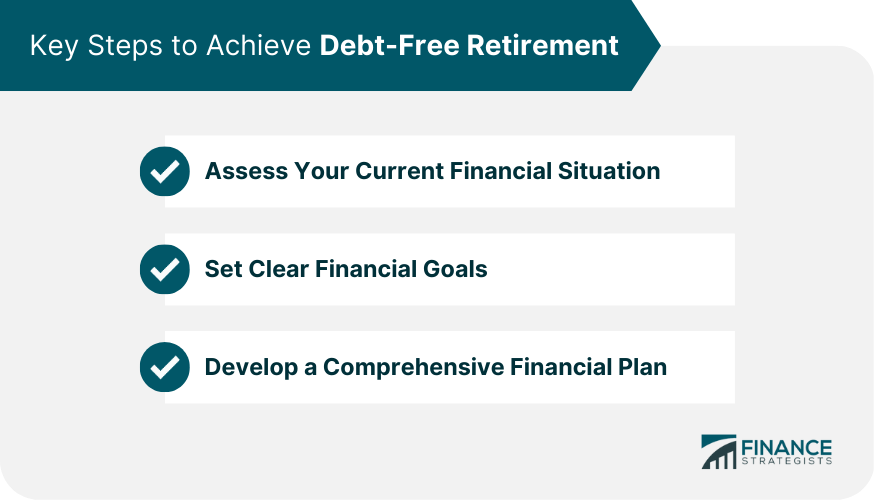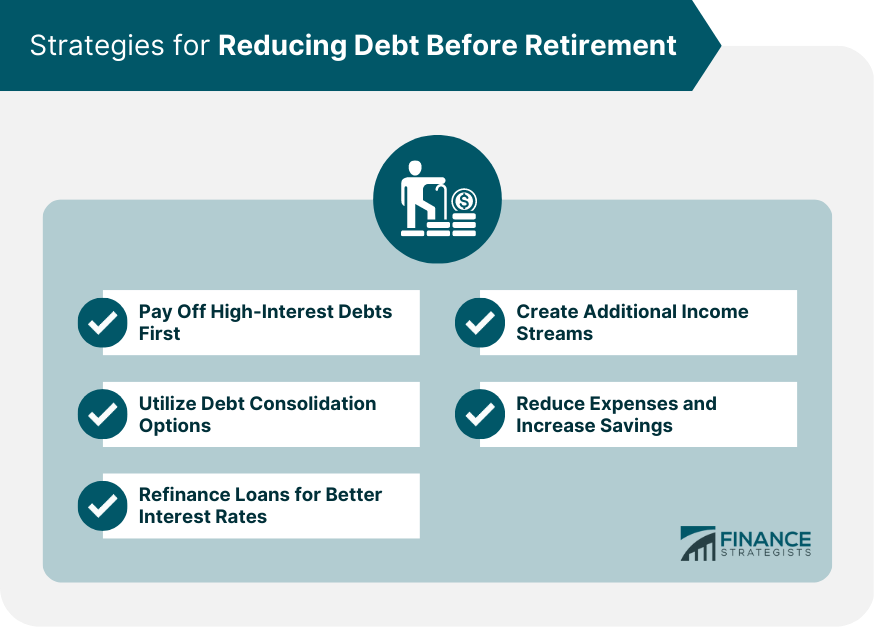What Is Debt-Free Retirement?
Debt-free retirement refers to the financial state of being free from any outstanding debt obligations upon entering retirement.
This means that individuals have successfully paid off all their loans, mortgages, and credit card balances, allowing them to enjoy their retirement years without the burden of debt repayments.
Planning for a debt-free retirement is essential for ensuring financial security and peace of mind during one's golden years.
By eliminating debt before retirement, individuals can maximize their retirement savings and focus on enjoying their desired lifestyle, rather than worrying about monthly debt payments.
Key Steps to Achieve Debt-Free Retirement
Assess Your Current Financial Situation
List Current Debts
Begin by making a list of all your outstanding debts, including mortgages, car loans, student loans, and credit card balances. This will provide a clear picture of your current financial standing and help you prioritize your debt repayment efforts.
Calculate Net Worth
Calculate your net worth by subtracting your total liabilities (debts) from your total assets. This calculation will give you an indication of your financial health and provide a benchmark for monitoring your progress towards a debt-free retirement.
Set Clear Financial Goals
Define Retirement Age
Determine the age at which you want to retire. This will help you establish a timeline for achieving a debt-free retirement and inform your overall financial plan.
Determine Desired Retirement Lifestyle
Envision the lifestyle you want to maintain during retirement, including your desired living expenses, travel plans, and any other financial goals you may have. This will help you calculate the amount of retirement savings you need to achieve a debt-free retirement.
Develop a Comprehensive Financial Plan
Establish a Budget
Create a budget to track your income and expenses, and identify areas where you can cut costs. This will allow you to allocate more funds towards debt repayment and retirement savings.
Prioritize Debt Repayment
Focus on paying off high-interest debt first, as it will save you money on interest payments over time. Create a debt repayment plan that outlines your strategy for tackling each debt, including the order in which you'll pay them off and the monthly payment amounts.
Build an Emergency Fund
Establish an emergency fund to cover at least 3-6 months' worth of living expenses. This will provide a financial safety net in case of unexpected expenses or emergencies, preventing you from taking on new debt during your journey to a debt-free retirement.
Invest for Long-Term Growth
Invest in a diversified portfolio that aligns with your risk tolerance and time horizon. Focus on long-term growth to maximize your retirement savings and help achieve your financial goals.

Strategies for Reducing Debt Before Retirement
Pay Off High-Interest Debts First
Prioritize paying off debts with the highest interest rates, as these are the most expensive over time. By paying off high-interest debt first, you'll reduce the overall interest you pay and accelerate your progress towards a debt-free retirement.
Utilize Debt Consolidation Options
Consider consolidating multiple high-interest debts into a single lower-interest loan. This can simplify your debt repayment process, lower your monthly payments, and save you money on interest.
Refinance Loans for Better Interest Rates
Explore refinancing options for loans with high interest rates. By refinancing to a lower interest rate, you can save money on interest payments and pay off your debt more quickly.
Create Additional Income Streams
Identify opportunities to generate additional income, such as taking on part-time work, freelancing, or starting a small business. This extra income can be used to accelerate debt repayment and increase your retirement savings.
Reduce Expenses and Increase Savings
Analyze your spending habits and identify areas where you can cut back on expenses. Redirect the money saved towards debt repayment and retirement savings, accelerating your progress towards a debt-free retirement.

Importance of Retirement Savings and Investments
Diversify Investment Portfolio
Diversify your investment portfolio to spread risk and increase the potential for long-term growth. Invest in a mix of assets, such as stocks, bonds, and real estate, to protect against market fluctuations and economic downturns.
Understand Tax-Advantaged Retirement Accounts
Familiarize yourself with tax-advantaged retirement accounts, such as 401(k)s, IRAs, and Roth IRAs. These accounts allow you to save for retirement while reducing your current tax liability, and can offer significant tax benefits during retirement.
Monitor and Adjust Investments Regularly
Regularly review and adjust your investment portfolio to ensure it remains aligned with your financial goals and risk tolerance. This may involve rebalancing your asset allocation or making changes to your investment strategy as you approach retirement.
Seek Professional Financial Advice
Consider working with a financial advisor to help you develop and maintain a comprehensive financial plan. An advisor can provide personalized guidance and recommendations to help you achieve a debt-free retirement.
Implementing Debt-Free Retirement Habits
Live Within Your Means
Adopt a frugal lifestyle and prioritize spending on necessities over luxuries. This will help you avoid accumulating new debt and allow you to focus on paying off existing debts.
Avoid New Debt
Resist the temptation to take on new debt, even if it means delaying large purchases or making sacrifices in the short term. Maintaining a debt-free lifestyle is crucial for achieving a debt-free retirement.
Continuously Educate Yourself on Personal Finance
Stay informed about personal finance topics, such as budgeting, investing, and tax planning. This knowledge will empower you to make informed financial decisions and stay on track towards a debt-free retirement.
Stay Disciplined and Committed to Your Financial Plan
Maintain a strong commitment to your financial plan, even when faced with setbacks or obstacles. Stay disciplined and focused on your long-term goals, and remember that achieving a debt-free retirement requires consistent effort and dedication.
Navigating Retirement With Financial Confidence
Develop a Sustainable Withdrawal Strategy
Create a withdrawal strategy for your retirement savings that ensures your funds last throughout your retirement years. This may involve adjusting your withdrawal rate based on market conditions, inflation, and your changing financial needs.
Plan for Healthcare Costs
Factor in healthcare expenses as part of your retirement plan, as these costs can be significant during your retirement years. Consider options such as long-term care insurance and Health Savings Accounts (HSAs) to help cover healthcare costs.
Stay Prepared for Unexpected Expenses
Maintain an emergency fund during retirement to cover unexpected expenses, such as home repairs or medical emergencies. This will help you avoid taking on new debt and protect your retirement savings.
Reassess and Adjust Financial Plan as Needed
Regularly evaluate your financial plan during retirement, making adjustments as necessary to accommodate changes in your lifestyle, income, or financial goals. This ongoing process will help you maintain financial stability and confidence throughout your retirement years.
Conclusion
A debt-free retirement offers numerous benefits, including reduced stress, increased financial flexibility, and an improved standard of living. By eliminating debt before retirement, you can focus on enjoying your golden years without the burden of monthly debt payments.
Achieving a debt-free retirement is possible with careful planning, discipline, and commitment to your financial goals.
Start by assessing your current financial situation, setting clear goals, and developing a comprehensive financial plan. Implement strategies for reducing debt and increasing savings, and stay disciplined in your approach.
By staying focused and committed to your financial plan, you can achieve a debt-free retirement and enjoy the peace of mind that comes with financial security.
Debt-Free Retirement FAQs
Yes, it is possible to achieve a debt-free retirement by paying off all outstanding debts before retirement, living within a budget, and planning and saving for retirement early and consistently.
Some common types of debt that can impact retirement finances include credit card debt, mortgage debt, student loan debt, and car loan debt.
Individuals can work towards a debt-free retirement by creating a budget and living within their means, paying off all outstanding debts before retirement, and prioritizing retirement savings early and consistently.
Some potential benefits of achieving a debt-free retirement include greater financial security, increased flexibility and freedom in retirement, and the ability to focus on other retirement goals and priorities.
Retirees can manage debt and expenses in retirement by creating a comprehensive retirement income plan, evaluating all sources of income and potential expenses, and developing strategies to reduce or eliminate debt and manage ongoing expenses. Working with a financial advisor can also be helpful in creating and implementing a retirement income plan.
True Tamplin is a published author, public speaker, CEO of UpDigital, and founder of Finance Strategists.
True is a Certified Educator in Personal Finance (CEPF®), author of The Handy Financial Ratios Guide, a member of the Society for Advancing Business Editing and Writing, contributes to his financial education site, Finance Strategists, and has spoken to various financial communities such as the CFA Institute, as well as university students like his Alma mater, Biola University, where he received a bachelor of science in business and data analytics.
To learn more about True, visit his personal website or view his author profiles on Amazon, Nasdaq and Forbes.











